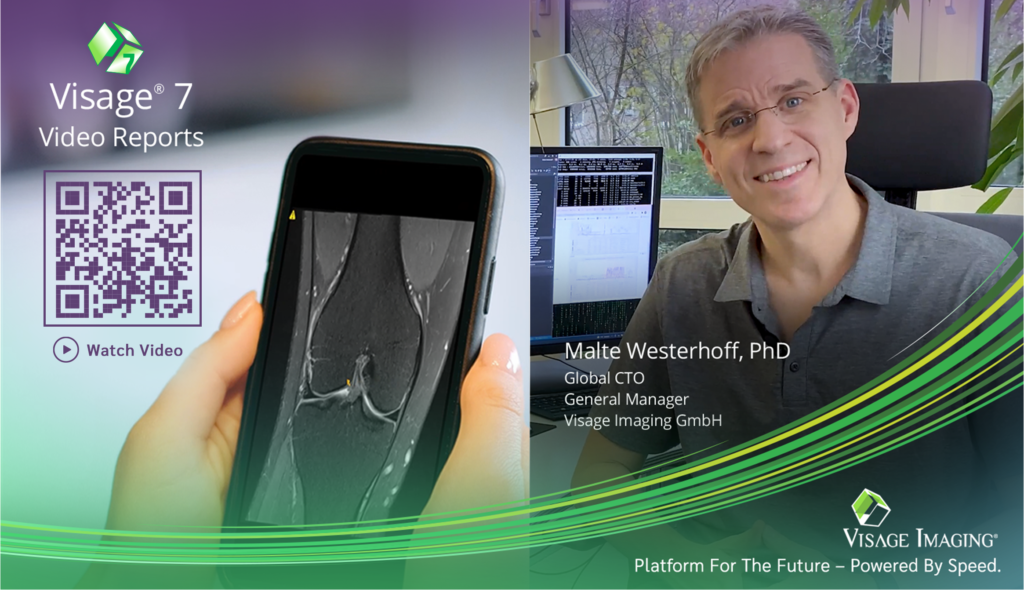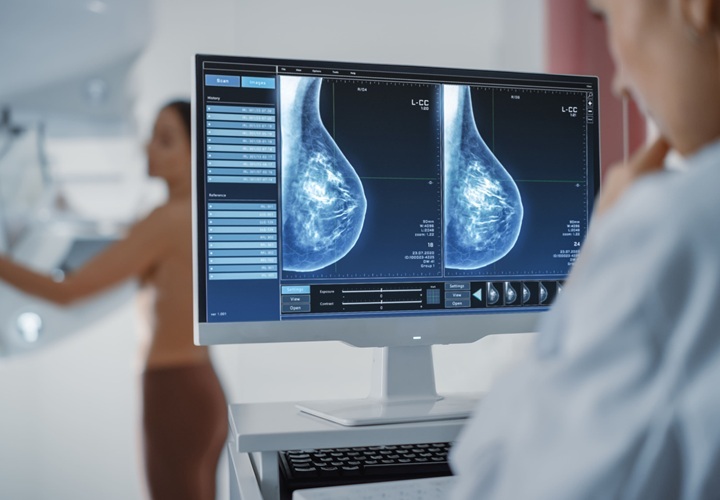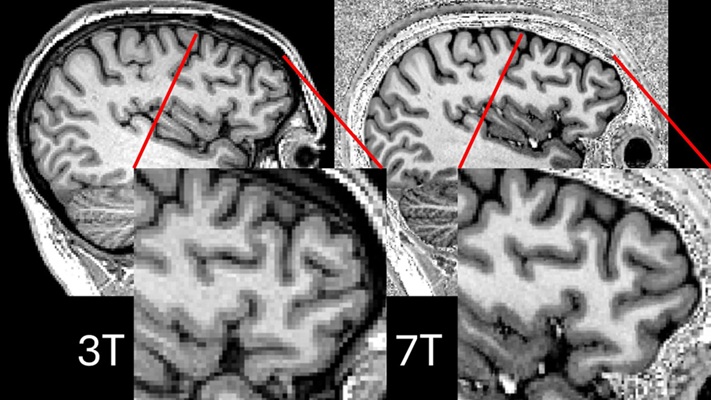Visage Imaging Introduces Easy to Create Video Radiology Reports for Improved Patient Engagement at RSNA 2021
|
By MedImaging International staff writers Posted on 01 Dec 2021 |

Visage Imaging, Inc. (San Diego, CA, USA) demonstrated Visage 7 Video Reports at the Radiological Society of North America (RSNA) 2021 annual meeting held in Chicago, November 28 – Wednesday, December 1, 2021.
AT RSNA 2021, the company announced the global release and availability of Visage 7 Video Reports as a standard feature of version 7.1.17 of the Visage 7 Enterprise Imaging Platform. Traditional radiology reports are filled with complex language and medical jargon that is challenging for patients to understand. While multimedia radiology reports (e.g., reports with key images and embedded tables) may include additional useful information, images are still tough for patients to decipher in the context of radiology report findings.
Visage’s video radiology report provides a new and better way for radiologists to communicate with patients. The video report is approximately one minute in length and is neither a comprehensive report, nor a replacement for the traditional radiology report for referring physicians. Visage 7 Video Reports includes easy to use tools, enabling the interpreting radiologist to quickly create and edit video reports recording 2D and 3D image manipulations directly within Visage 7, while also using the same microphone used for voice recognition. Visage 7 Video Reports are conveniently and securely accessed by patients at home or on mobile devices via their electronic health record (EHR) portal.
At RSNA 2021, Visage also showcased the latest version of the Visage 7 Enterprise Imaging Platform, purpose built and engineered for CloudPACS. Today’s healthcare institutions want to implement modern, flexible, high performance enterprise imaging solutions designed for scale, security and maximum uptime. Visage’s differentiated technology enables radiologists to read with lightning-fast speed and diagnostic precision from either on premise (on customer owned hardware), or via multi-cloud implementations. Visage continues to pioneer complete PACS replacement in the cloud, successfully bringing live the world’s largest CloudPACS implementations. Visage’s experience has been that cloud-based implementations of Visage 7 have the same great performance as on-premise Visage 7 implementations, or in many cases even faster. This is because Visage 7 in the cloud uses highly parallel I/O streams to object-based cloud storage; dynamic allocation of cloud resources for elasticity; and the maximum use of network connections streaming 100% on-demand while using less bandwidth than legacy PACS.
“The Enterprise Imaging move to the cloud has steadily increased over the past several years and Visage has been leading the transformation,“ explained Malte Westerhoff, PhD, Visage Co-Founder and Global Chief Technology Officer. Dr. Westerhoff continued, “Visage built our reputation on having the fastest PACS anywhere when implemented on premise and we’ve raised the bar yet again. We’ve proven that having a cloud-engineered platform provides customers with an even faster Visage 7 experience, while also providing unprecedented security and scalability. This is groundbreaking innovation in action.”
Related Links:
Visage Imaging, Inc.
Latest RSNA 2021 News
- Samsung Showcases Its Premium Diagnostic Imaging Solutions in Ultrasound, DR and Mobile CT at RSNA 2021
- Konica Minolta Introduces New High Performance Mobile X-Ray and High-Definition FPD at RSNA 2021
- Hologic Showcases Extensive Portfolio of Breast and Skeletal Health Products at RSNA 2021
- Agfa Healthcare Launches its New Valory Digital Radiography (DR) Room at RSNA 2021
- GE Healthcare Introduces Industry’s First Modular, Scalable Computed Tomography (CT) Platform at RSNA 2021
- Fujifilm Launches New High Performance Velocity MRI System at RSNA 2021
- Bracco Celebrates Personalized and Precision Medicine Innovations at RSNA 2021
- PaxeraHealth Launches Ark Platform to Make AI More Accessible and Affordable at RSNA 2021
- IBM Watson Health Presents New Portfolio of Solutions Designed for Enterprise Imaging, Radiology and Cardiology at RSNA 2021
- Varex Exhibits Highly Innovative Photon Counting X-Ray Detectors at RSNA 2021
- Carestream Showcases Enhanced DR Room Imaging and AI Innovations at RSNA 2021
- Guerbet Showcases Comprehensive Range of Imaging Products, Solutions, and Services for Diagnostic Imaging at RSNA 2021
- Sectra Highlights Brilliant Radiology Workflows at RSNA 2021
- Barco Presents Solutions for Mammography, Remote Radiology Reading, Interventional Radiology and QA at RSNA 2021
- Siemens Unveils World’s First Photon-Counting CT at RSNA 2021
- Canon Unveils New Vantage Fortian Advanced Productivity, Open Bore 1.5T MRI System at RSNA 2021
Channels
Radiography
view channel
Higher Chest X-Ray Usage Catches Lung Cancer Earlier and Improves Survival
Lung cancer continues to be the leading cause of cancer-related deaths worldwide. While advanced technologies like CT scanners play a crucial role in detecting lung cancer, more accessible and affordable... Read more
AI-Powered Mammograms Predict Cardiovascular Risk
The U.S. Centers for Disease Control and Prevention recommends that women in middle age and older undergo a mammogram, which is an X-ray of the breast, every one or two years to screen for breast cancer.... Read moreMRI
view channel
Ultra-Powerful MRI Scans Enable Life-Changing Surgery in Treatment-Resistant Epileptic Patients
Approximately 360,000 individuals in the UK suffer from focal epilepsy, a condition in which seizures spread from one part of the brain. Around a third of these patients experience persistent seizures... Read more
AI-Powered MRI Technology Improves Parkinson’s Diagnoses
Current research shows that the accuracy of diagnosing Parkinson’s disease typically ranges from 55% to 78% within the first five years of assessment. This is partly due to the similarities shared by Parkinson’s... Read more
Biparametric MRI Combined with AI Enhances Detection of Clinically Significant Prostate Cancer
Artificial intelligence (AI) technologies are transforming the way medical images are analyzed, offering unprecedented capabilities in quantitatively extracting features that go beyond traditional visual... Read more
First-Of-Its-Kind AI-Driven Brain Imaging Platform to Better Guide Stroke Treatment Options
Each year, approximately 800,000 people in the U.S. experience strokes, with marginalized and minoritized groups being disproportionately affected. Strokes vary in terms of size and location within the... Read moreUltrasound
view channel
Tiny Magnetic Robot Takes 3D Scans from Deep Within Body
Colorectal cancer ranks as one of the leading causes of cancer-related mortality worldwide. However, when detected early, it is highly treatable. Now, a new minimally invasive technique could significantly... Read more
High Resolution Ultrasound Speeds Up Prostate Cancer Diagnosis
Each year, approximately one million prostate cancer biopsies are conducted across Europe, with similar numbers in the USA and around 100,000 in Canada. Most of these biopsies are performed using MRI images... Read more
World's First Wireless, Handheld, Whole-Body Ultrasound with Single PZT Transducer Makes Imaging More Accessible
Ultrasound devices play a vital role in the medical field, routinely used to examine the body's internal tissues and structures. While advancements have steadily improved ultrasound image quality and processing... Read moreNuclear Medicine
view channel
Novel Radiotracer Identifies Biomarker for Triple-Negative Breast Cancer
Triple-negative breast cancer (TNBC), which represents 15-20% of all breast cancer cases, is one of the most aggressive subtypes, with a five-year survival rate of about 40%. Due to its significant heterogeneity... Read more
Innovative PET Imaging Technique to Help Diagnose Neurodegeneration
Neurodegenerative diseases, such as amyotrophic lateral sclerosis (ALS) and Alzheimer’s disease, are often diagnosed only after physical symptoms appear, by which time treatment may no longer be effective.... Read moreGeneral/Advanced Imaging
view channel
AI Model Significantly Enhances Low-Dose CT Capabilities
Lung cancer remains one of the most challenging diseases, making early diagnosis vital for effective treatment. Fortunately, advancements in artificial intelligence (AI) are revolutionizing lung cancer... Read more
Ultra-Low Dose CT Aids Pneumonia Diagnosis in Immunocompromised Patients
Lung infections can be life-threatening for patients with weakened immune systems, making timely diagnosis crucial. While CT scans are considered the gold standard for detecting pneumonia, repeated scans... Read moreImaging IT
view channel
New Google Cloud Medical Imaging Suite Makes Imaging Healthcare Data More Accessible
Medical imaging is a critical tool used to diagnose patients, and there are billions of medical images scanned globally each year. Imaging data accounts for about 90% of all healthcare data1 and, until... Read more
Global AI in Medical Diagnostics Market to Be Driven by Demand for Image Recognition in Radiology
The global artificial intelligence (AI) in medical diagnostics market is expanding with early disease detection being one of its key applications and image recognition becoming a compelling consumer proposition... Read moreIndustry News
view channel
GE HealthCare and NVIDIA Collaboration to Reimagine Diagnostic Imaging
GE HealthCare (Chicago, IL, USA) has entered into a collaboration with NVIDIA (Santa Clara, CA, USA), expanding the existing relationship between the two companies to focus on pioneering innovation in... Read more
Patient-Specific 3D-Printed Phantoms Transform CT Imaging
New research has highlighted how anatomically precise, patient-specific 3D-printed phantoms are proving to be scalable, cost-effective, and efficient tools in the development of new CT scan algorithms... Read more
Siemens and Sectra Collaborate on Enhancing Radiology Workflows
Siemens Healthineers (Forchheim, Germany) and Sectra (Linköping, Sweden) have entered into a collaboration aimed at enhancing radiologists' diagnostic capabilities and, in turn, improving patient care... Read more
















![Image: [18F]3F4AP in a human subject after mild incomplete spinal cord injury (Photo courtesy of The Journal of Nuclear Medicine, DOI:10.2967/jnumed.124.268242) Image: [18F]3F4AP in a human subject after mild incomplete spinal cord injury (Photo courtesy of The Journal of Nuclear Medicine, DOI:10.2967/jnumed.124.268242)](https://globetechcdn.com/mobile_medicalimaging/images/stories/articles/article_images/2025-02-24/Brugarolas_F8.large.jpg)



